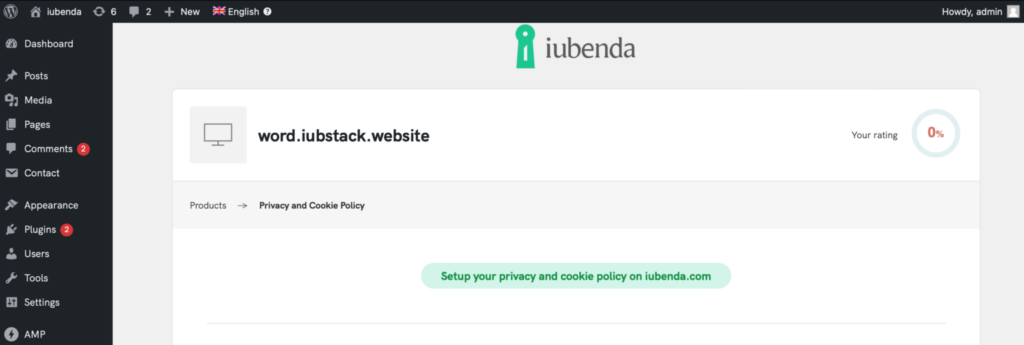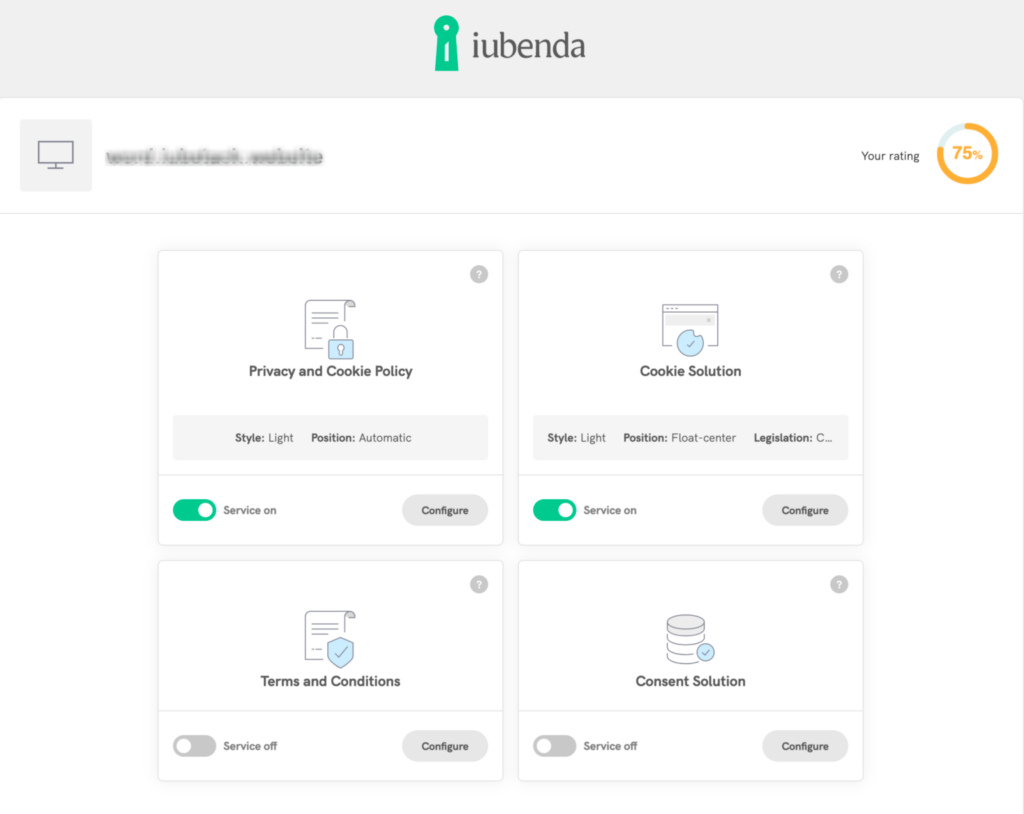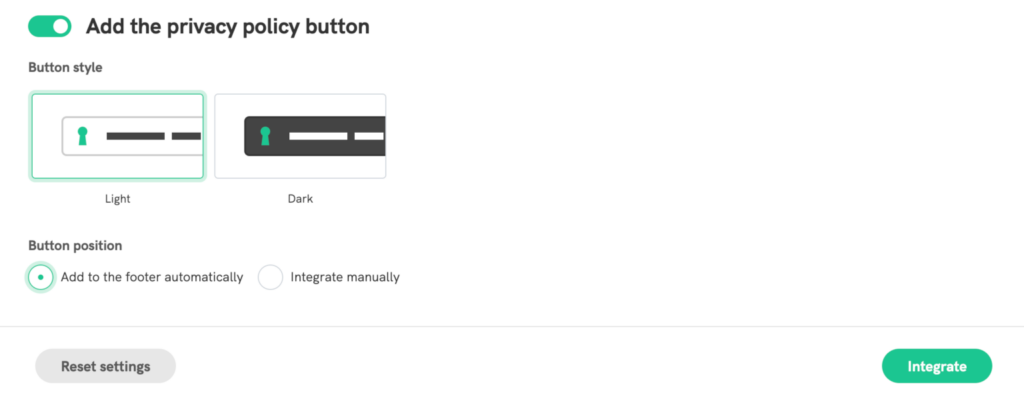Documentation
How to Add a Privacy Policy to Your WordPress Site
Have a WordPress site to carry out your business activities? Do you collect personal data like email or IP addresses from your users? Chances are you do. Then, by law, you need to post a WordPress privacy policy on your website. As a WordPress user, you have various options to do so and that we will cover in this article, including easy plugins made specifically for this popular content management system.
Having a clear and comprehensive privacy policy on your website is important for legal reasons, but also to build trust and transparency. It outlines how personal data is collected, processed, disclosed, protected, and is legally required under most privacy laws worldwide.
👀 Let’s delve into the essentials of adding a privacy policy to your WordPress site, covering key questions and providing actionable guidance to make this a super easy easy process for you!
Short on time? Jump to ⬇️
- Do I really need a privacy policy on my website?
- Do I need a privacy policy on my WordPress website?
- Does WordPress have a privacy policy generator?
- What is the plugin for privacy policy in WordPress?
- How do I get the privacy policy link in WordPress?
- How to create your own WordPress privacy policy
- What should a privacy policy include
- Where to display your policy on your site
- How to add your privacy policy to your WordPress site
- 🚀 A quick and easy solution: the iubenda plugin
Do I really need a privacy policy on my website?
Yes, you very likely need a privacy policy on your website, because it is highly probable nowadays that your business activities online (e.g. marketing campaigns) or the technologies present on your site (e.g. social media buttons, forms) involve the collection of users’ personal data.
What you need to know is that a privacy policy is a legal requirement in many jurisdictions such as the General Data Protection Regulation (GDPR) in Europe or state laws in the US. They mandate that websites collecting personal data from their users must have a privacy policy in place. On top of that, it’s a best practice to include one on your site to enhance transparency and user confidence.
Do I need a privacy policy on my WordPress website?
Yes, you need a privacy policy if your WordPress site collects any form of personal data, whether it’s through contact forms, comments, subscriptions, or analytics tools. This applies to nearly all websites today, as even basic functionality like user registration or comment sections involves the collection of personal data. Luckily, as WordPress is a popular CMS, there are a number of ways to generate and then add your privacy policy easily.
Does WordPress have a privacy policy generator?
Yes, WordPress includes a built-in feature to help you build your own privacy policy directly on the CMS. However, be aware that the WordPress privacy policy generator offers a general template that can serve as a starting point.
It’s accessible through the ‘Settings’ > ‘Privacy’ section of your WordPress dashboard. There, you can select a pre-existing page to serve as your privacy policy or create a new one. Beware though that the template includes basic sections on data collection and sharing, so it’s important to customize it to accurately reflect your site’s specific practices to avoid risks of non-compliance.
What is the plugin for privacy policy in WordPress?
There are several plugins available that can assist in generating and managing your site’s privacy policy. WordPress has its own built-in feature that you can access in the Settings > Privacy, but it’s quite limited (i.e. it will only allow you to create a basic legal document) so you might want to check out more professional options.
The iubenda plugin is one such option, offering all-in-one solutions like privacy and cookie policy, terms and conditions, consent banner and more. It specifically integrates with WordPress and can be found in the WordPress library. It’s a great alternative to generate legally compliant privacy policies tailored to your specific needs and operations.
💡 WordPress plugins can save time, generate high-quality documents that cover necessary legal bases.
How do I get the privacy policy link in WordPress?
To get the privacy policy link in WordPress, you need to have created your privacy policy page. You can do that with the WordPress built-in feature or other specialized privacy compliance plugins that allow you to generate your document and a link in a few minutes.
After that, you’ll want to make your privacy policy easily accessible to your visitors, best practice is in your website’s footer. To add a link there, go to ‘Appearance’ > ‘Menus’ in your WordPress dashboard. You can add your privacy policy page to any menu of your choice.
How to create your own WordPress privacy policy
1. Free online templates
You can decide to create your privacy policy using free online templates. Many websites offer customizable templates with blanks to fill in with your specific business information.
🔍 This method is clearly cost-effective but will only give you a rough idea of the structure of the document, since it can only be basic in order to be used by so many businesses. You will still have to write detailed legal clauses that refer to your operations.
💡 Check out this privacy policy template
2. Consulting with a legal professional
For a more tailored approach and for more complex documents, consulting with a legal professional specialized in this field is advisable. A lawyer can help draft a document that not only complies with all applicable laws but also addresses the specific nuances of how your WordPress site operates.
🔍 Quite the opposite of the above option as it can get quite expensive, especially since you’ll have to keep your document up-to-date at all times. However, it provides a higher level of security and customization.
3. WordPress built-in privacy policy feature
WordPress includes a built-in feature to help site owners create a privacy policy. It provides a template that covers general aspects of privacy policies and offers guidance on what additional information might be needed depending on your site’s specific functionalities.
To use this feature:
- Go to your WordPress dashboard;
- Navigate to Settings > Privacy;
- You can either select an existing page or create a new one to serve as your privacy policy page;
- If you need to create a document from scratch, hit Create.

🔍 This option is a good starting point, especially for new site owners unfamiliar with the requirements of a privacy policy. It’s easy-to-use since everything happens on WordPress and is simplified to add your document on a page of your site.
However, as WordPress mentions in their guide: “WordPress will automatically generate a policy with some personalized details from your website. We recommend reading the default information and tweaking it to fit your needs.” It’s quite limited in terms of quality and customization, WordPress not being an expert in the legal sector.
3. A privacy policy generator & plugin for WordPress
The best compromise in terms of quality vs. price and ease-of-use among all the options we have seen before would be to use a specialized legal privacy plugin for WordPress.
🔍 The iubenda plugin, for instance, is particularly useful for sites that operate in multiple countries or regions, as it helps ensure compliance with a wide range of privacy laws. iubenda has been an expert in the field of privacy even before GDPR became a thing. With iubenda:
- Generating and installing your document is made easy and specific for your WordPress site;
- Quality and legal compliance is ensured with lawyer-crafted clauses and products;
- High level of customization for your document with +2000 clauses, 14 languages;
- Automatically kept up-to-date as the law and your website change.
👋 Here’s how simple it is to create a privacy policy for WordPress using iubenda:

- Install the iubenda plugin from the WordPress plugin directory here;
- Insert your URL, our plugin scans your site and analyzes your compliance rate;
- Choose to create a privacy policy (and any other elements you need, such as a consent banner);
- Set up your account on the iubenda website to create your policy directly from there;
- Use our great and intuitive privacy policy generator & site scanner to detect which clauses to add;
- Return to the plugin on WordPress and save settings;
- Your privacy policy will synchronize automatically without any code or copypasting!
💡 Want to learn more? Check out our installation guide.

What should a privacy policy include
A privacy policy for a WordPress site serves as a crucial document to inform users about how their personal information is collected, used, stored, and protected. We provide below a summary of the main sections your document should contain.
Scope and Updates of the Privacy Policy
This section outlines the extent of the privacy policy, specifying the types of users it applies to (e.g., website visitors, registered users) and the data it covers. It also details how and when the policy is updated and how users will be notified of any changes.
Controller, Data Protection Officer, and Contact
Defines who the “controller” of the data is (i.e., the entity responsible for data processing on the site), contact information for the data protection officer (if applicable), and how users can get in touch with them regarding privacy concerns or inquiries.
What Personal Data You Collect, Process, Share
Describes the specific types of personal data the website collects from users (e.g., name, email address, IP address), including data generated from website use, registrations, and any other sources like cookies or contact forms. Also mentions who the data is shared with or disclosed to (categories of recipients or third-parties).
Example: “Our website includes social media features, such as the Facebook Like button and widgets. These features may collect your IP address, which page you are visiting on our site, and may set a cookie to enable the feature to function properly. Social media features and widgets are either hosted by a third party or hosted directly on our site.”
Why You Collect this Data
Explains why the website collects personal data (the purposes), the legal basis for processing such data (e.g., consent, contract necessity, legal requirements).
Example: “This website collects personal information from its users for various purposes, including but not limited to, improving user experience, managing user accounts, and providing targeted advertising. The types of information collected may include names, email addresses, and browsing behaviors. By using this website, you consent to the collection and use of your information as detailed in this policy.”
International Data Transfers [If applicable]
Details any transfer of personal data outside the user’s country or international organization, including the measures in place to ensure data protection (e.g., Standard Contractual Clauses, adhering to the EU-US Data Privacy Framework, etc.)
Storage Duration and Erasure
Specifies how long personal data is stored and the criteria used to determine this duration. It also explains how and when the data is erased or anonymized once it’s no longer needed for the purposes for which it was collected.
User Rights
Outlines the rights of users regarding their personal data, such as the right to access, correct, delete, restrict processing of their data, the right to data portability, and how they can exercise these rights.
Cookies & Similar Technologies
Explains the use of cookies and similar technologies (e.g. pixel tags) on the site, what information they collect, how they are used (e.g., for analytics, personalization), and how users can manage or opt-out of them.
💡 Learn everything you need to know about cookie policies here.
Data Security
Describes the security measures in place to protect personal data from unauthorized access, alteration, disclosure, or destruction. This might include technical measures (e.g., encryption, secure servers) and organizational measures (e.g., access controls, training for staff).
Regional and State Privacy Disclosures
Addresses specific privacy laws and regulations applicable to users from certain regions or states (e.g., GDPR for European Union residents, CCPA/CPRA for California residents), including any additional rights or disclosures required under those laws.
💡 Each section should be concise yet comprehensive, ensuring users understand their privacy rights and how their data is handled on your WordPress site. Make sure it’s clear, readable and avoids unnecessary legal jargon. Update your policy regularly as your website evolves or new legislation comes into effect.
Where to display your policy on your site
It’s best practice to make your privacy policy easily accessible, typically from the footer of your website. To enhance visibility, you can also incorporate the privacy policy link in pop-ups or banners that appear when users initially interact with your website (e.g. your cookie consent banner).
When individuals sign up for newsletters or updates, it is crucial to prominently display the privacy policy link. This is especially important since users are providing personal information such as their names and email addresses.
The checkout process is another essential area where the policy link should be included.
How to add your privacy policy to your WordPress site
Create a new page and paste your policy
If you already have an existing privacy policy in a text format, you can always create a new page on WordPress, copy the document there, and then follow the instructions in the next section to add this page to your WordPress site’s footer.
- Go to Settings > Privacy;
- Select the existing page from the drop-down menu next to Change Your Privacy Policy Page;
- Hit Use This Page.
👋 There are some limitations to copy and pasting your document as a static text. You will have to go back to it every time it needs to be updated. Remember that this is a legal requirement; your privacy policy should always reflect your current practices and existing legislations.
Use WordPress’s built-in feature
As we’ve seen before, WordPress allows you to create a privacy document and then add it to your site. Here’s how to do it.
- Once you’ve created your privacy policy, publish the page;
- To add to the footer, go to Appearances > Menus. You’ll see an Add menu items section on the left;
- Select your privacy policy page;
- Then click on Add to Menu;
- You can drag the page to the order you want on the right-hand side;
- Finally, click on Save Menu at the bottom left of the page.
Integrate automatically with the iubenda plugin
After you have followed the setup wizard to create your privacy policy on iubenda, you will be redirected to WordPress and the plugin. That’s when you can then choose the button style and position.
If you select the “Add to the footer automatically” option, the widget will be automatically displayed in the footer of every page of your WordPress site! Yes, it’s that easy.

💡 Pro tip: Any changes you make on the iubenda generator automatically reflect your WordPress privacy policy. So, when you’re done configuring your documents on iubenda.com, you can return to the plugin, click on Save Settings, and your privacy and cookie policy will be updated!
Enjoy Immediate Peace of Mind With the iubenda Privacy Policy Generator WordPress Plugin
👉 Industry-specialized privacy solutions created by legal experts for full site compliance
👉 Wizard and site scanner for easy and quick document generation
👉 High level of customization and self-updates when the law changes
👉 Foolproof automatic and dynamic integration on your WordPress site’s footer
